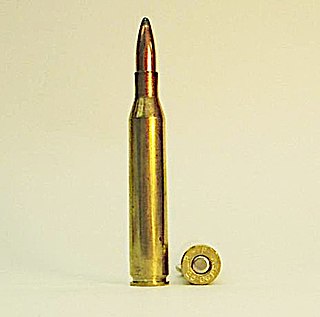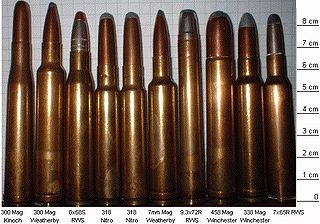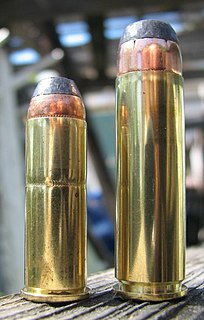
The .38 Super, also known as .38 Super +P, .38 Super Auto, .38 Super Automatic, .38 Super Automatic +P, or 9×23mmSR, is a pistol cartridge that fires a 0.356-inch-diameter (9.04 mm) bullet. It was introduced in the late 1920s as a higher pressure loading of the .38 ACP, also known as .38 Auto. The older .38 ACP cartridge propels a 130-grain (8.4 g) bullet at 1,050 ft/s (320.0 m/s), whereas the .38 Super pushes the same bullet at 1,280 ft/s (390.1 m/s). The .38 Super has gained distinction as the caliber of choice for many top practical shooting competitors; it remains one of the dominant calibers in IPSC competition.

The .22 Long Rifle or simply .22 LR is a long-established variety of .22 caliber rimfire ammunition originating from the United States. It is used in a wide range of rifles, pistols, revolvers, smoothbore shotguns, and submachine guns.
Internal ballistics, a subfield of ballistics, is the study of the propulsion of a projectile.

The .44 Smith & Wesson Special, also commonly known as .44 S&W Special, .44 Special, .44 Spl, .44 Spc,, or 10.9x29mmR is a smokeless powder center fire metallic revolver cartridge developed by Smith & Wesson in 1907 as the standard chambering for their New Century revolver, introduced in 1908.

Practical shooting, also known as dynamic shooting or action shooting, is a set of shooting sports where the competitors try to unite the three principles of precision, power, and speed, by using a firearm of a certain minimum power factor to score as many points as possible during the shortest amount of time. While scoring systems vary between organizations, each measures the time of which the course is completed, with penalties for inaccurate shooting. The courses are called "stages", and are shot individually by the shooters. Usually the shooter must move and shoot from several positions, fire under or over obstacles and in other unfamiliar positions. There are no standard exercises or set arrangement of the targets, and the courses are often designed so that the shooter must be inventive, and therefore the solutions of exercises sometimes varies between shooters.

The International Practical Shooting Confederation (IPSC) is the world's largest shooting sport association, and the largest and oldest within practical shooting. Founded in 1976, the IPSC nowadays affiliates over 100 regions from Africa, Americas, Asia, Europe, the Middle East, and Oceania. Competitions are held with pistol, revolver, rifle, and shotgun, and the competitors are divided into different divisions based on firearm and equipment features. While everyone in a division competes in the Overall category, there are also separate awards for the categories Lady, Super Junior, Junior, Senior, and Super Senior.

Considered by many as the most balanced of the "quarter bores" for hunting medium sized game, the .25-06 Remington remained in obscurity as a wildcat cartridge for nearly half a century before being standardized by Remington in 1969.

The .458 Winchester Magnum is a belted, straight-taper cased, big five game rifle cartridge. It was introduced commercially in 1956 by Winchester and first chambered in the Winchester Model 70 African rifle. It was designed to compete against the .450 Nitro Express and the .470 Nitro Express cartridges used in big bore British double rifles. The .458 Winchester Magnum remains one of the most popular large game cartridges, and most major ammunition manufacturers offer a selection of .458 ammunition.

The 7mm-08 Remington is a rifle cartridge that is almost a direct copy of a wildcat cartridge developed around 1958 known as the 7mm/308. As these names would suggest, it is the .308 Winchester case necked down to accept 7 mm (.284) bullets with a small increase in case length. Of cartridges based upon the .308, it is the second most popular behind only the .243 Winchester. However, the .308 is more popular than both. In 1980, the Remington Arms company popularized the cartridge by applying its own name and offering it as a chambering for their Model 788 and Model 700 rifles, along with a limited-run series within their Model 7600 pump-action rifles during the early 2000s.

A racegun or race gun is a firearm that has been modified for accuracy, speed, and reliability. Often a semi-automatic pistol, raceguns are used primarily in practical shooting competitions and are modified to function best within a certain set of rules, such as weight, size, and capacity requirements.

The .400 Corbon is an automatic pistol cartridge developed by Cor-Bon in 1997. It was created to mimic the ballistics of the 10 mm Auto cartridge in a .45 ACP form factor. It is essentially a .45 ACP case, necked down to .40 caliber with a 25-degree shoulder.

Overpressure ammunition, commonly designated as +P or +P+, is small arms ammunition that has been loaded to produce a higher internal pressure when fired than is standard for ammunition of its caliber, but less than the pressures generated by a proof round. This is done typically to produce rounds with a higher muzzle velocity and stopping power, such as ammunition used for defensive or hunting purposes. Because of this, +P ammunition is typically found in handgun calibers which might be used for defensive purposes.

The United States Practical Shooting Association(USPSA) is the national governing body of practical shooting in the United States under the International Practical Shooting Confederation (IPSC). Its over 35,000 active members and over 500 affiliated clubs make USPSA the largest practical shooting organization in the United States and the second largest region within IPSC after the Russian Federation of Practical Shooting. USPSA publishes a monthly member magazine called Front Sight.
Free recoil is a vernacular term or jargon for recoil energy of a firearm not supported from behind. Free recoil denotes the translational kinetic energy (Et) imparted to the shooter of a small arm when discharged and is expressed in joules (J), or foot-pound force (ft·lbf) for non-SI units of measure. More generally, the term refers to the recoil of a free-standing firearm, in contrast to a firearm securely bolted to or braced by a massive mount or wall. Free recoil should not be confused with recoil:

The 9×25mm Dillon is a pistol wildcat cartridge developed for use in USPSA/IPSC Open guns. The cartridge is made by necking down a 10mm Auto case to 9 mm.

The 9×23mm Winchester is a pistol cartridge developed as a joint venture by Winchester Ammunition and Colt's Manufacturing Company. The 9×23mm Winchester has a convoluted development history, but was commercially introduced by Winchester in 1996. Marketed primarily to competition shooters as a replacement for .38 Super for International Practical Shooting Confederation, United States Practical Shooting Association and International Defensive Pistol Association competition, the cartridge failed to find significant market success despite a high-profile introduction.

The .500 S&W Magnum or 12.7×41mmSR is a .50 caliber semi-rimmed revolver cartridge developed by Cor-Bon in partnership with the Smith & Wesson "X-Gun" engineering team for use in the Smith & Wesson Model 500 X-frame revolver and introduced in February 2003 at the SHOT Show. It has two primary design purposes: as a hunting handgun cartridge capable of taking all North American game species, and to be the most powerful production handgun cartridge to date.

Dynamic Sports Shooting Norway (DSSN), NorwegianDynamisk Sportsskyting Norge (DSSN), is the Norwegian association for practical shooting under the International Practical Shooting Confederation. It was constituted in 1979 as Norges Forbund for Praktisk Skyting (NFPS), and changed its name to Dynamisk Sportsskyting Norge in 2013.

Multigun, Multi Gun or Multi-Gun, often also called 2-Gun or 3-Gun depending on the types of firearms used, are practical shooting events where each of the stages require the competitor to use a combination of handguns, rifles, and/or shotguns Multigun has a lot in common with ordinary IPSC/ USPSA single gun matches, and matches generally have courses of fire where the shooter must move through different stages and engage targets in a variety of different positions.
The .277 Wolverine (6.8×39mm) is a wildcat cartridge. It is a multi-purpose mid-power cartridge with increased ballistic performance over the AR-15's traditional .223 Remington cartridge requiring only a new barrel to upgrade/convert any 5.56-based firearm to .277 Wolverine.
























